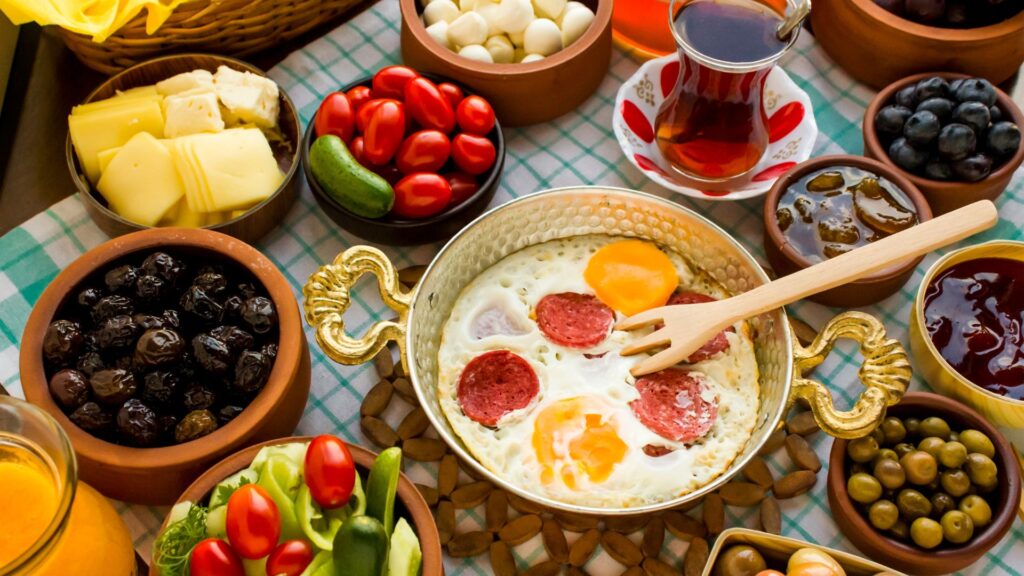Estimated reading time: 8 minutes
Key points
- Explore the characteristics of traditional Arabic cuisine, from mezze to kebabs, spices, and cooking techniques.
- Learn about Arabic spices like za’atar, baharat, sumac.
- Learn how to prepare an authentic Arabic meal at home.
Table of Contents
- Overview of Traditional Arabic Cuisine
- Core Ingredients of Traditional Arabic Cuisine
- Mezze in Traditional Arabic Cuisine: Appetizers to Share
- Traditional Arabic Kebab: Styles, Marinades, and Grilling Techniques
- Traditional Arabic Spices and How to Use Them for Mezze & Kebabs
- The Authentic Arabic Meal: Structure from Mezze to Dessert
- Drinks and Desserts in Traditional Arabic Cuisine
- Sample “Authentic Arabic Meal” Menu + Shopping List
- Tips for Cooking Traditional Arabic Cuisine at Home (Adapted for Vietnamese Kitchens)
Hello, Nuhaira is back! Every trip through the Arab lands leaves me not only with memories of golden deserts or ancient souks, but also with the rich aftertaste of a unique culinary culture. Traditional Arabic cuisine is a symphony of flavors, where tangy, creamy, aromatic, and warm notes skillfully blend, expressed through the culture of sharing meals and distinctive techniques of grilling, stewing, and pickling.
Despite spanning diverse regions from the Levant to the Gulf and the Maghreb, the soul of this cuisine always emphasizes connecting with family and friends through cozy, shared meals. In this article, let’s explore with Nuhaira from A to Z: what mezze is, famous types of kebabs, the secrets of Arabic spices like za’atar, baharat, and sumac, and most importantly, how you can prepare an authentic Arabic meal right at home, with tips suitable for a Vietnamese kitchen.
Overview of Traditional Arabic Cuisine
Traditional Arabic cuisine is a term that encompasses the cooking methods and culinary culture of Arab countries. Its most distinctive feature is the spirit of sharing, where people gather around a communal spread, using pieces of warm flatbread instead of spoons to enjoy the food. A typical meal always follows a clear order: starting with mezze appetizers, followed by the main course, and ending with dessert accompanied by tea or coffee.
The sophistication of this cuisine lies in its perfect balance of flavors:
- Tanginess: From fresh lemon and sumac powder.
- Creaminess: From extra virgin olive oil, rich tahini sauce, and smooth yogurt.
- Aroma: From fresh herbs like parsley, mint, and countless signature spices.
- Warmth: Created by charcoal grilling techniques or slow simmering for many hours.
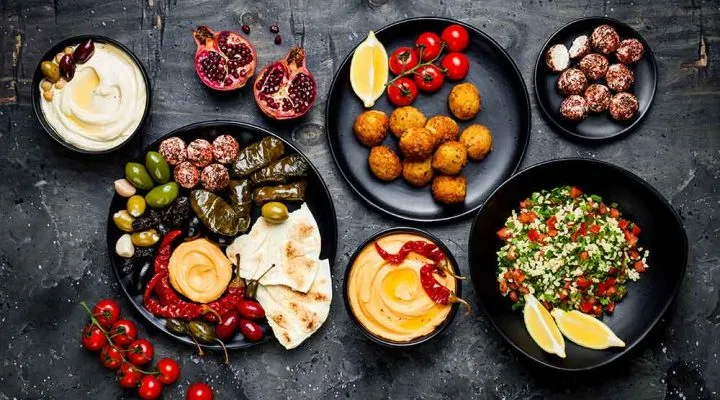
Three major regions have shaped this diverse culinary landscape:
- The Levant (Lebanon, Syria, Jordan): Famous for its abundant mezze spreads, za’atar and 7-spice blends, and the renowned Tabbouleh salad with plenty of fresh parsley.
- The Gulf (Saudi Arabia, UAE): Characterized by spiced rice dishes like Kabsa and Mandi, where the aroma of cardamom and precious saffron is considered the soul of the dish, a distinctive feature of Saudi Arabian cuisine.
- The Maghreb (Morocco, Tunisia): Known for the complex spice blend ras el hanout, spicy harissa paste, stews cooked in earthenware tagines, and couscous (wheat granules).
Core Ingredients of Traditional Arabic Cuisine
To create their characteristic flavors, Arab chefs rely on the following core ingredients:
- Starches:
- Flatbread (pita/khubz): A leavened bread that puffs up when baked to form a pocket, perfect for scooping mezze or stuffing with kebabs.
- Basmati rice: Long, aromatic grains that are the foundation for pilaf, kabsa, and mandi dishes.
- Bulgur: Cracked wheat that has been parboiled and dried, a key ingredient in tabbouleh salad and kibbeh.
- Couscous: Tiny steamed granules of semolina, very popular in the Maghreb region.
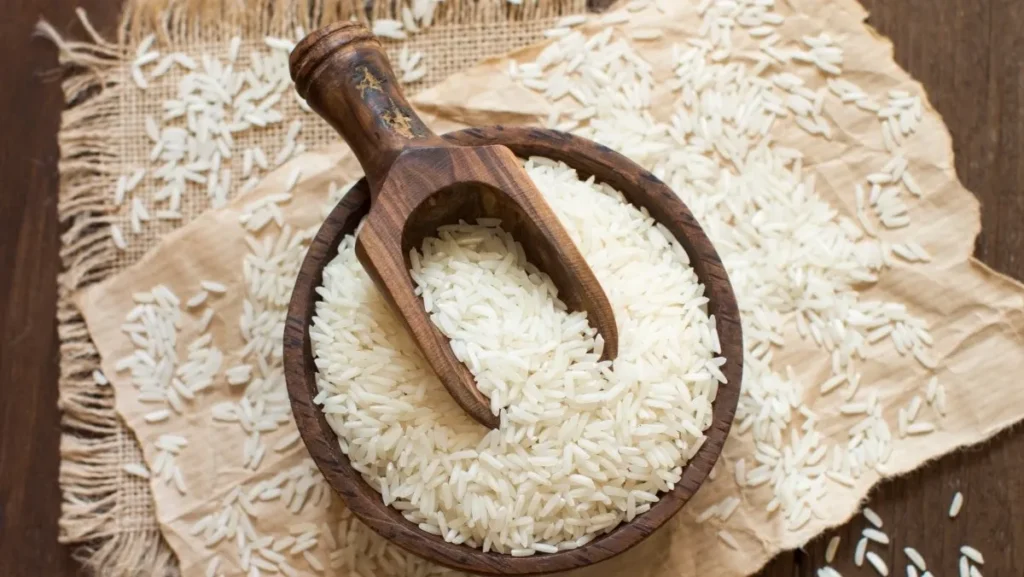
Basmati rice
- Proteins:
- Chickpeas and lentils: The foundation of countless mezze dishes and nutritious soups.
- Lamb, beef, chicken, fish: Lamb holds a particularly important place, often used for kebabs and main stews.
- Fats & Sauces:
- Extra virgin olive oil: Used generously in most dishes.
- Ghee: Clarified butter where milk solids are removed, it has a high smoke point and a characteristic nutty aroma.
- Tahini: A paste made from ground sesame seeds, creating creaminess in hummus and many other sauces.
- Yogurt/Labneh: Regular yogurt or strained yogurt (labneh) which has a thick, cream cheese-like texture.
- Herbs and produce: Parsley, mint, dill, eggplant, cucumber, tomato, and pomegranate seeds are indispensable ingredients, bringing freshness and color to the dishes.
Mezze in Traditional Arabic Cuisine: Appetizers to Share
Mezze is not just an appetizer; it’s a culinary ritual, a collection of small dishes served in the center of the table for everyone to enjoy and converse together. A proper mezze spread is often arranged very methodically:
- Cold before hot: Cold dishes like hummus, baba ghanoush, muhammara, and labneh are served first, along with olives, pickles (mukhalal), and salads. Then come the hot dishes like falafel or stuffed grape leaves.
- Balance of textures and flavors: An ideal spread will have 1-2 creamy dishes (hummus), 1-2 crispy items (falafel), 1-2 tangy dishes (fattoush salad), and something slightly spicy (muhammara).
Here are the classic mezze dishes you must try:
- Hummus: A smooth dip made from soft-cooked chickpeas, blended with tahini, lemon juice, garlic, and a little ice water to create a fluffy texture.
- Baba Ghanoush: Eggplant grilled directly over an open flame until the skin is charred and the inside is meltingly soft, then the flesh is scraped out and mixed with tahini, lemon, and garlic. The characteristic smoky flavor is the soul of this dish.
- Muhammara: A mildly spicy dip made from roasted red bell peppers, walnuts, breadcrumbs, and a touch of pomegranate molasses for a deep sweet-and-sour flavor.
- Labneh: Strained Greek yogurt, thick like cream cheese, drizzled with olive oil and sprinkled with za’atar.
- Tabbouleh: A refreshing salad where finely chopped parsley is the main ingredient, mixed with mint, tomatoes, bulgur wheat, and a lemon-olive oil dressing.
- Falafel: Crispy fried patties made from soaked (not boiled) dried chickpeas, ground with herbs and spices.
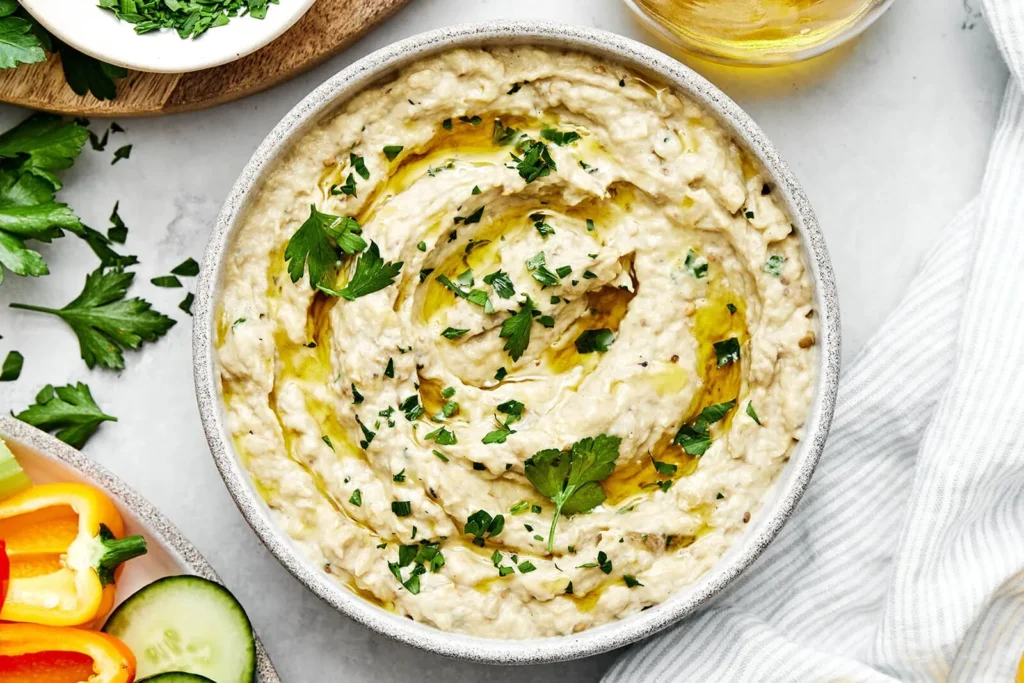
Baba Ghanoush
Traditional Arabic Kebab: Styles, Marinades, and Grilling Techniques
Kebab is not just grilled skewered meat; it’s an art of marinating and using heat.
- Types of kebab:
- Shish Kebab: Meat (lamb, beef, chicken) cut into cubes, skewered, and grilled.
- Kofta Kebab: Ground meat mixed with grated onion, herbs, and spices (usually baharat or 7-spice), then molded around a skewer.
- Adana/Urfa Kebab: A very popular Turkish specialty, made from ground lamb and tail fat, molded onto wide, flat skewers. Adana is spicy, while Urfa is milder.
- Doner/Shawarma: Unlike skewered kebabs, these are large cones of meat layered on a vertical rotisserie, cooked, and shaved into thin slices.
- Standard marinade recipes:
- For shish kebab (beef/lamb): Marinate the meat with olive oil, crushed garlic, baharat spice, cumin, pepper, salt, and lemon juice for at least 2 hours.
- For kofta kebab: Mix ground meat with grated onion (with excess water squeezed out), chopped parsley, baharat/7-spice, and a little breadcrumb to create a tender, juicy texture.
- Cooking technique: Grilling over charcoal is best, but you can absolutely use an oven or air fryer at a high temperature (200-230°C). Always let the meat rest for a few minutes after cooking to retain its moisture.
Kebabs are often served with basmati rice, warm pita bread, an onion salad with sumac, and sauces like toum (garlic sauce) or tahini sauce.
Traditional Arabic Spices and How to Use Them for Mezze & Kebabs
Spices are the heart of Arabic cuisine, creating depth and distinction.
- Spice Blends:
- Za’atar: A blend of thyme/oregano, toasted sesame seeds, and sumac. It’s often sprinkled on labneh or pita bread grilled with olive oil.
- Baharat: A “warm” spice blend including black pepper, cinnamon, cloves, nutmeg, cumin… used for marinating meat.
- Lebanese 7-spice: Similar to Baharat but with additional flavors like ginger and allspice.
- Ras el hanout: “King of spices” from the Maghreb region, can contain dozens of different ingredients, creating an extremely complex flavor profile.
- Individual spices: Cumin, coriander, cardamom, cinnamon, turmeric, saffron, and sumac (a tangy berry powder) are the most commonly used.
- Flavor pairing tips:
- Hummus: Sprinkle with sumac or paprika for decoration and flavor.
- Kofta/Kebab: Always needs baharat or 7-spice as a base.
- Rice: Adding a few cardamom pods and a small cinnamon stick while cooking will make basmati rice wonderfully fragrant.
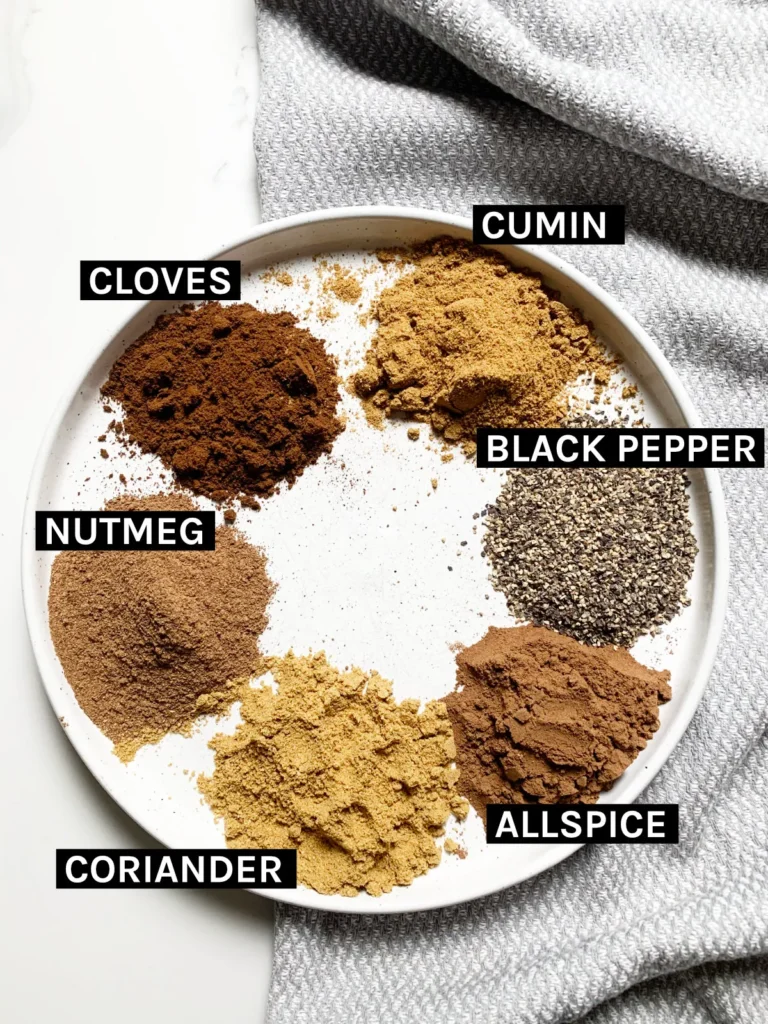
Lebanese 7-spice
The Authentic Arabic Meal: Structure from Mezze to Dessert
Creating an authentic Arabic meal is about creating a culinary journey. The culture of hospitality and sharing is a core element, reflected in the way the table is set and guests are invited.
- Sequence: The meal begins with a diverse mezze spread. Then, the main course, such as kebab, tagine stews, or kabsa/mandi rice, is served. Finally, mint tea or qahwa coffee is offered for dessert and conversation.
- Table etiquette: Always use your right hand to eat, use pita bread as a natural spoon, and don’t hesitate to try dishes from the shared plates.
Drinks and Desserts in Traditional Arabic Cuisine
The end of a meal is incomplete without the sweetness of characteristic desserts and drinks.
- Drinks:
- Mint Tea: Green or black tea brewed very sweet with plenty of fresh mint leaves.
- Arabic Coffee (Qahwa): Very lightly roasted coffee, brewed with cardamom, served without sugar in small cups, and often accompanied by dates.
- Ayran/Laban: A refreshing drink made from yogurt diluted with water and a pinch of salt.

Arabic Coffee
- Desserts:
- Baklava: Multiple layers of paper-thin phyllo dough alternated with nuts and ghee, then drenched in a fragrant sugar syrup.
- Kunafa: An Arabic-style cheese pastry with a crispy crust made from shredded kataifi dough or semolina, drizzled with rosewater or orange blossom syrup.
- Umm Ali: An Egyptian-style bread pudding, rich with milk and nuts.
Sample “Authentic Arabic Meal” Menu + Shopping List
To help you get started easily, Nuhaira suggests 2 sample menus:
- Menu 1 (Classic):
- Mezze: Hummus, Fattoush salad, Labneh with za’atar.
- Main Course: Kofta kebab served with basmati rice cooked with cardamom.
- Drinks & Dessert: Mint tea and Kunafa.
- Menu 2 (Vegetarian):
- Mezze: Hummus, Baba Ghanoush, Muhammara, Tabbouleh.
- Main Course: Falafel served with pita bread and salad.
- Drinks & Dessert: Mint lemonade and vegetarian Baklava.
Core Shopping List:
- Dry goods: Chickpeas, basmati rice, bulgur wheat, tahini paste.
- Spices: Za’atar, baharat (or 7-spice), sumac, cumin.
- Fresh items: Ground lamb/beef, plain yogurt, parsley, mint, lemon, eggplant, cucumber.
Tips for Cooking Traditional Arabic Cuisine at Home (Adapted for Vietnamese Kitchens)
Don’t worry if you can’t find all the ingredients!
- Substitutions: No sumac? Use lemon juice and a little lemon zest. Make your own labneh by straining plain yogurt through cheesecloth for 12-24 hours.
- Equipment: A cast-iron grill pan will create beautiful char marks on your kebabs. To get a smoky flavor for baba ghanoush, grill the eggplant directly over a gas stove flame using tongs.
- Optimize flavor: Marinate kebabs overnight. Adding grated and squeezed onion to kofta will make the meat extremely tender and juicy.
Conclusion
The soul of an authentic Arabic meal lies in the trio of mezze – kebab – spices, along with the warm culture of sharing around the dining table. It is a colorful culinary experience, balancing tangy, creamy, aromatic, and warm flavors, that will surely captivate you.
Hopefully, Nuhaira’s sharing will inspire you to confidently step into the kitchen and explore this wonderful culinary world. Try starting with a simple mezze platter, and you’ll see that bringing the flavors of the Middle East home is not as difficult as you might think.
See more:

